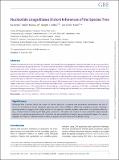Files in this item
Nucleotide usage biases distort inferences of the species tree
Item metadata
| dc.contributor.author | Borges, Rui | |
| dc.contributor.author | Boussau, Bastien | |
| dc.contributor.author | Szöllősi, Gergely J | |
| dc.contributor.author | Kosiol, Carolin | |
| dc.date.accessioned | 2022-01-21T15:30:15Z | |
| dc.date.available | 2022-01-21T15:30:15Z | |
| dc.date.issued | 2022-01 | |
| dc.identifier | 277421573 | |
| dc.identifier | 1b558621-0b47-444a-ae40-d1869f305efd | |
| dc.identifier | 34983052 | |
| dc.identifier | 85123812662 | |
| dc.identifier | 000796735400009 | |
| dc.identifier.citation | Borges , R , Boussau , B , Szöllősi , G J & Kosiol , C 2022 , ' Nucleotide usage biases distort inferences of the species tree ' , Genome Biology and Evolution , vol. 14 , no. 1 , evab290 . https://doi.org/10.1093/gbe/evab290 | en |
| dc.identifier.issn | 1759-6653 | |
| dc.identifier.uri | https://hdl.handle.net/10023/24732 | |
| dc.description | This work was supported by the Vienna Science and Technology Fund (WWTF) [MA16-061] and partially supported by the Austrian Science Fund (FWF) [P34524-B]. GJS received funding from the European Research Council under the European Union’s Horizon 2020 research and innovation program under grant agreement no. 714774 and the grant GINOP-2.3.2.-15-2016-00057. | en |
| dc.description.abstract | Despite the importance of natural selection in species' evolutionary history, phylogenetic methods that take into account population-level processes typically ignore selection. The assumption of neutrality is often based on the idea that selection occurs at a minority of loci in the genome and is unlikely to compromise phylogenetic inferences significantly. However, genome-wide processes like GC-bias and some variation segregating at the coding regions are known to evolve in the nearly neutral range. As we are now using genome-wide data to estimate species trees, it is natural to ask whether weak but pervasive selection is likely to blur species tree inferences. We developed a polymorphism-aware phylogenetic model tailored for measuring signatures of nucleotide usage biases to test the impact of selection in the species tree. Our analyses indicate that while the inferred relationships among species are not significantly compromised, the genetic distances are systematically underestimated in a node-height dependent manner: i.e., the deeper nodes tend to be more underestimated than the shallow ones. Such biases have implications for molecular dating. We dated the evolutionary history of 30 worldwide fruit fly populations, and we found signatures of GC-bias considerably affecting the estimated divergence times (up to 23%) in the neutral model. Our findings call for the need to account for selection when quantifying divergence or dating species evolution. | |
| dc.format.extent | 13 | |
| dc.format.extent | 712734 | |
| dc.language.iso | eng | |
| dc.relation.ispartof | Genome Biology and Evolution | en |
| dc.subject | Species tree | en |
| dc.subject | Selection | en |
| dc.subject | Nearly neutral evolution | en |
| dc.subject | GC-bias | en |
| dc.subject | Molecular dating | en |
| dc.subject | QH301 Biology | en |
| dc.subject | QH426 Genetics | en |
| dc.subject | DAS | en |
| dc.subject.lcc | QH301 | en |
| dc.subject.lcc | QH426 | en |
| dc.title | Nucleotide usage biases distort inferences of the species tree | en |
| dc.type | Journal article | en |
| dc.contributor.institution | University of St Andrews. St Andrews Bioinformatics Unit | en |
| dc.contributor.institution | University of St Andrews. Centre for Biological Diversity | en |
| dc.contributor.institution | University of St Andrews. School of Biology | en |
| dc.identifier.doi | 10.1093/gbe/evab290 | |
| dc.description.status | Peer reviewed | en |
This item appears in the following Collection(s)
Items in the St Andrews Research Repository are protected by copyright, with all rights reserved, unless otherwise indicated.

